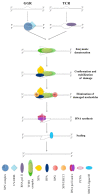Is DNA damage response ready for action anywhere?
- PMID: 23109871
- PMCID: PMC3472763
- DOI: 10.3390/ijms130911569
Is DNA damage response ready for action anywhere?
Abstract
Organisms are continuously exposed to DNA damaging agents, consequently, cells have developed an intricate system known as the DNA damage response (DDR) in order to detect and repair DNA lesions. This response has to be rapid and accurate in order to keep genome integrity. It has been observed that the condensation state of chromatin hinders a proper DDR. However, the condensation state of chromatin is not the only barrier to DDR. In this review, we have collected data regarding the presence of DDR factors on micronuclear DNA lesions that indicate that micronuclei are almost incapable of generating an effective DDR because of defects in their nuclear envelope. Finally, considering the recent observations about the reincorporation of micronuclei to the main bulk of chromosomes, we suggest that, under certain circumstances, micronuclei carrying DNA damage might be a source of chromosome instability.
Keywords: DSB repair; NER pathway; chromosome instability; micronuclei.
Figures



Similar articles
-
DNA lesions sequestered in micronuclei induce a local defective-damage response.DNA Repair (Amst). 2009 Oct 2;8(10):1225-34. doi: 10.1016/j.dnarep.2009.07.004. Epub 2009 Aug 14. DNA Repair (Amst). 2009. PMID: 19683478
-
Impaired nuclear functions in micronuclei results in genome instability and chromothripsis.Arch Toxicol. 2016 Nov;90(11):2657-2667. doi: 10.1007/s00204-016-1818-4. Epub 2016 Aug 19. Arch Toxicol. 2016. PMID: 27542123 Review.
-
Nuclear envelope defects impede a proper response to micronuclear DNA lesions.Mutat Res. 2012 Jan 3;729(1-2):35-40. doi: 10.1016/j.mrfmmm.2011.09.003. Epub 2011 Sep 16. Mutat Res. 2012. PMID: 21945242
-
An insight into understanding the coupling between homologous recombination mediated DNA repair and chromatin remodeling mechanisms in plant genome: an update.Cell Cycle. 2021 Sep;20(18):1760-1784. doi: 10.1080/15384101.2021.1966584. Epub 2021 Aug 26. Cell Cycle. 2021. PMID: 34437813 Free PMC article. Review.
-
Mitotic DNA Damage Response: At the Crossroads of Structural and Numerical Cancer Chromosome Instabilities.Trends Cancer. 2017 Mar;3(3):225-234. doi: 10.1016/j.trecan.2017.02.001. Epub 2017 Feb 28. Trends Cancer. 2017. PMID: 28718433 Free PMC article. Review.
Cited by
-
Synthetic lethality of a cell-penetrating anti-RAD51 antibody in PTEN-deficient melanoma and glioma cells.Oncotarget. 2019 Feb 12;10(13):1272-1283. doi: 10.18632/oncotarget.26654. eCollection 2019 Feb 12. Oncotarget. 2019. PMID: 30863489 Free PMC article.
-
Breast Cancer Induced by X-Ray Mammography Screening? A Review Based on Recent Understanding of Low-Dose Radiobiology.Med Princ Pract. 2016;25(2):101-9. doi: 10.1159/000442442. Epub 2015 Nov 16. Med Princ Pract. 2016. PMID: 26571215 Free PMC article.
References
-
- Fenech M., Kirsch-Volders M., Natarajan A.T., Surralles J., Crott J.W., Parry J., Norppa H., Eastmond D.A., Tucker J.D., Thomas P. Molecular Mechanisms of Micronucleus, Nucleoplasmic Bridge and Nuclear Bud Formation in Mammalian and Human Cells. Mutagenesis. 2011;26:125–132. - PubMed
-
- Shay J.W., Wright W.E. Senescence and Immortalization: Role of Telomeres and Telomerase. Carcinogenesis. 2005;26:867–874. - PubMed
-
- Latre L., Tusell L., Martin M., Miro R., Egozcue J., Blasco M.A., Genesca A. Shortened Telomeres Join to DNA Breaks Interfering with their Correct Repair. Exp. Cell Res. 2003;287:282–288. - PubMed
-
- Hoffelder D.R., Luo L., Burke N.A., Watkins S.C., Gollin S.M., Saunders W.S. Resolution of Anaphase Bridges in Cancer Cells. Chromosoma. 2004;112:389–397. - PubMed
Publication types
MeSH terms
Substances
LinkOut - more resources
Full Text Sources

